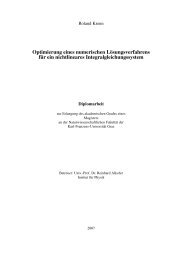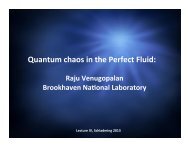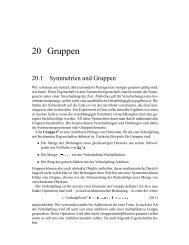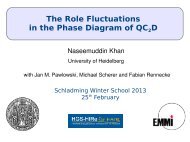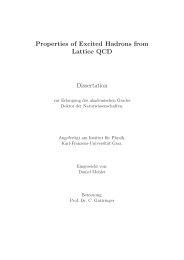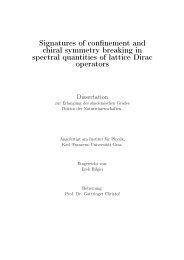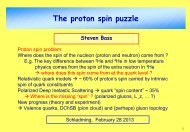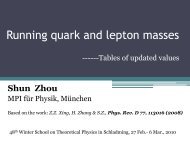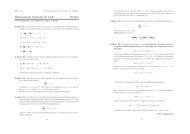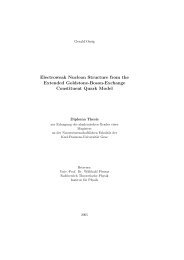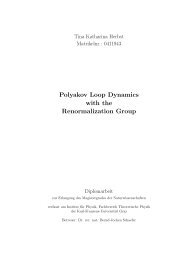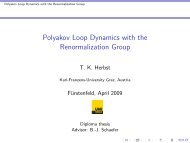The QCD Quark Propagator in Coulomb Gauge and - Institut für Physik
The QCD Quark Propagator in Coulomb Gauge and - Institut für Physik
The QCD Quark Propagator in Coulomb Gauge and - Institut für Physik
You also want an ePaper? Increase the reach of your titles
YUMPU automatically turns print PDFs into web optimized ePapers that Google loves.
Chapter 6. Nucleon Form Factors <strong>in</strong> a Covariant Diquark-<strong>Quark</strong> model 63<br />
the asymptotic behaviour familiar from perturbative analyses, cf. section 2.2, <strong>and</strong> that<br />
behaviour is unambiguously evident for p 2 10 GeV 2 [AS01].<br />
While numerical solutions of the quark DSE are now readily obta<strong>in</strong>ed, the utility of<br />
an algebraic form for S(p) when calculations require the evaluation of numerous multidimensional<br />
<strong>in</strong>tegrals is obvious. An suitable parametrisation of S(p), which exhibits the<br />
features described above, has been used extensively <strong>in</strong> hadron studies [AS01, MR03]. It is<br />
expressed via<br />
¯σ S (x) = 2 ¯m F(2(x + ¯m 2 )) + F(b 1 x) F(b 3 x) [b 0 + b 2 F(ǫx)] , (6.31)<br />
1 [<br />
¯σ V (x) = 1 − F(2(x + ¯m 2 )) ] , (6.32)<br />
x + ¯m 2<br />
with x = p 2 /λ 2 , ¯m = m/λ,<br />
F(x) = 1 − e−x<br />
, (6.33)<br />
x<br />
¯σ S (x) = λ σ S (p 2 ) <strong>and</strong> ¯σ V (x) = λ 2 σ V (p 2 ). <strong>The</strong> mass-scale, λ = 0.566 GeV, <strong>and</strong> parameter<br />
values 3 ¯m b 0 b 1 b 2 b 3<br />
0.00897 0.131 2.90 0.603 0.185 , (6.34)<br />
were fixed <strong>in</strong> a least-squares fit to light-meson observables [BRT96]. <strong>The</strong> dimensionless<br />
u = d current-quark mass <strong>in</strong> equation (6.34) corresponds to<br />
m u,d = 5.1 MeV . (6.35)<br />
<strong>The</strong> parametrisation yields a Euclidean constituent-quark mass<br />
M E u,d<br />
= 0.33 GeV, (6.36)<br />
def<strong>in</strong>ed as the solution of p 2 = M 2 (p 2 ), whose magnitude is typical of that employed <strong>in</strong><br />
constituent-quark models. In ref.[BRT96] it is shown that m s = 25 m u,d <strong>and</strong> M E s =<br />
0.49 GeV. It is generally true that M E s − M E u,d ˆm s − ˆm u,d , where ˆm denotes the<br />
renormalisation po<strong>in</strong>t <strong>in</strong>dependent current-quark mass. <strong>The</strong> constituent-quark mass is<br />
an expression of dynamical chiral symmetry break<strong>in</strong>g, as is the vacuum quark condensate 4<br />
(Λ <strong>QCD</strong> = 0.2 GeV)<br />
−〈¯qq〉 1GeV2<br />
0 = λ 3 3<br />
4π 2 b 0<br />
b 1 b 3<br />
ln 1 GeV2<br />
Λ 2 <strong>QCD</strong><br />
= (0.221 GeV) 3 . (6.37)<br />
3 ǫ = 10 −4 <strong>in</strong> equation (6.31) acts only to decouple the large- <strong>and</strong> <strong>in</strong>termediate-p 2 doma<strong>in</strong>s.<br />
4 <strong>The</strong> condensate is calculated directly from its gauge <strong>in</strong>variant def<strong>in</strong>ition [MR03] after mak<strong>in</strong>g allowance<br />
for the fact that equations(6.31) <strong>and</strong> (6.32) yield a chiral-limit quark mass function with anomalous<br />
dimension γ m = 1. This omission of the additional ln(p 2 /Λ 2 <strong>QCD</strong> )-suppression that is characteristic of<br />
<strong>QCD</strong> is merely a practical simplification.



